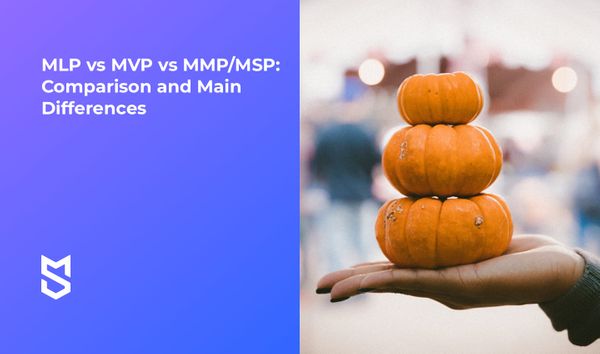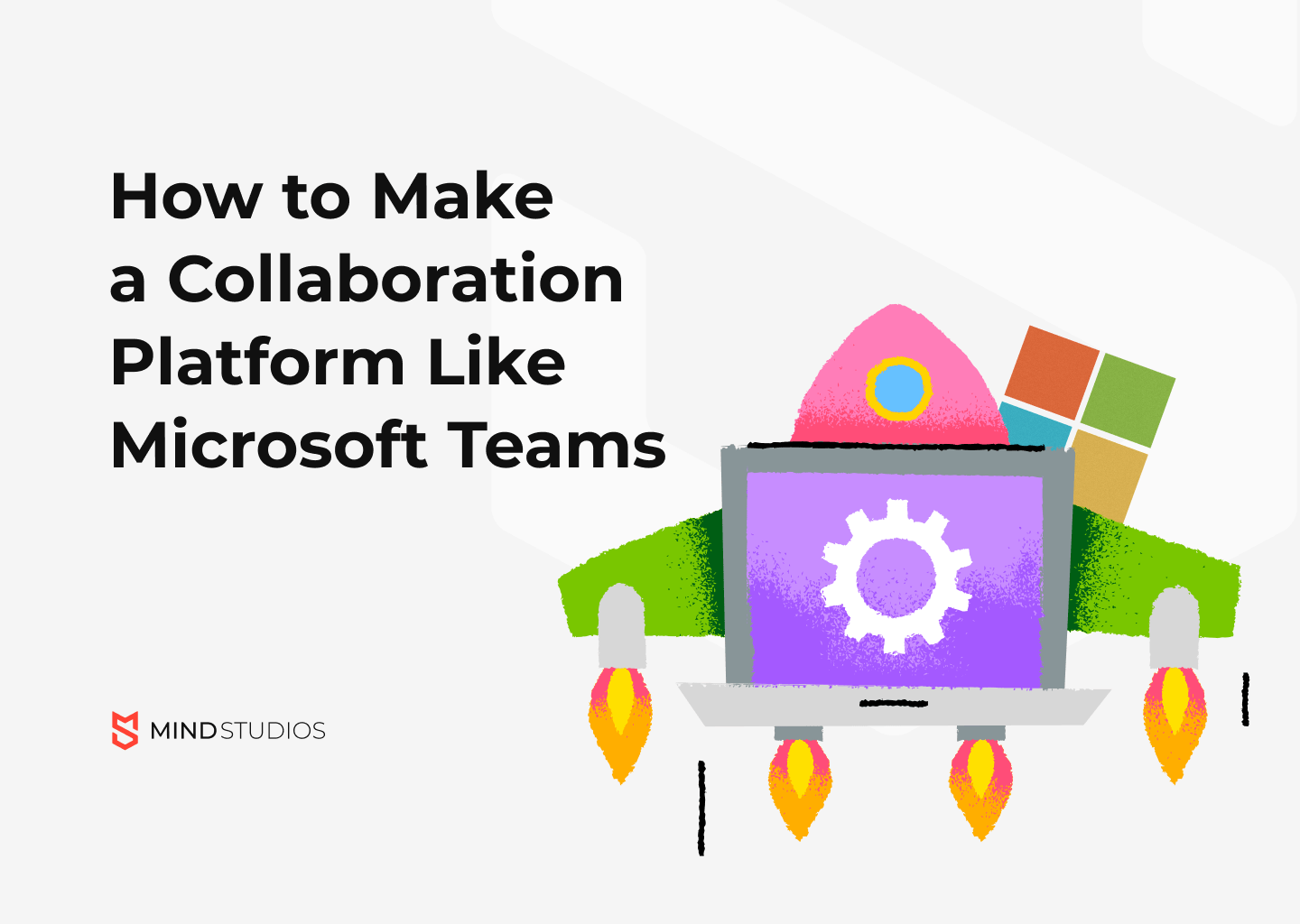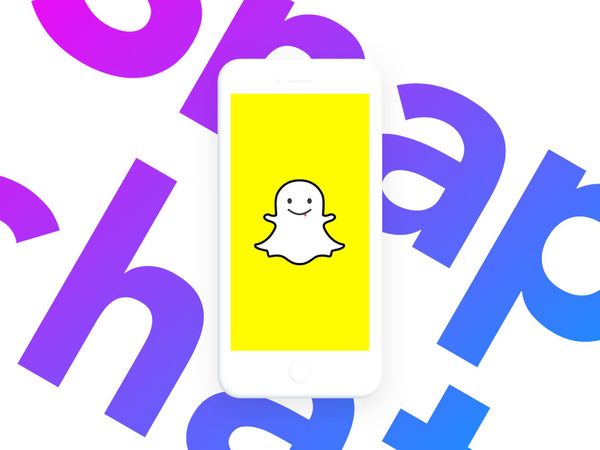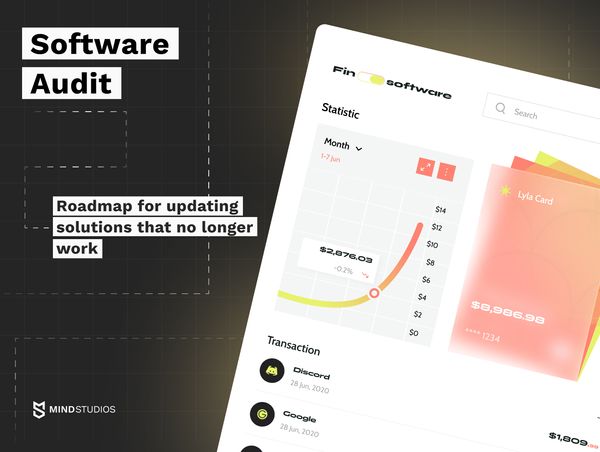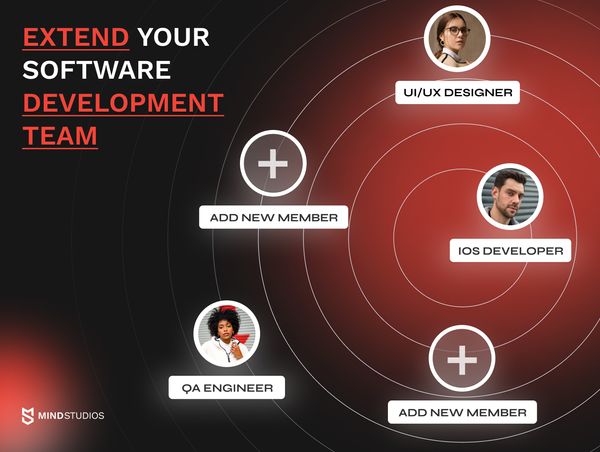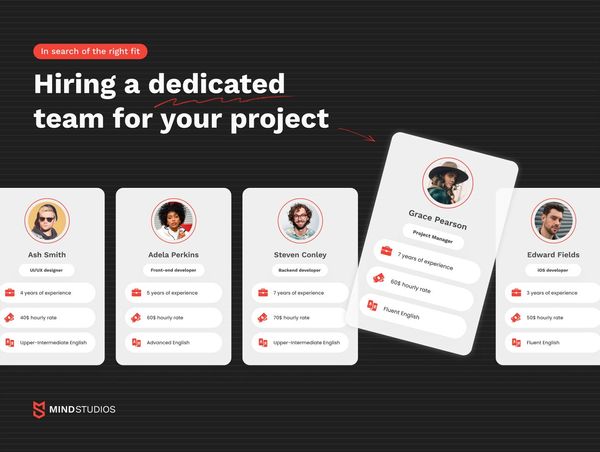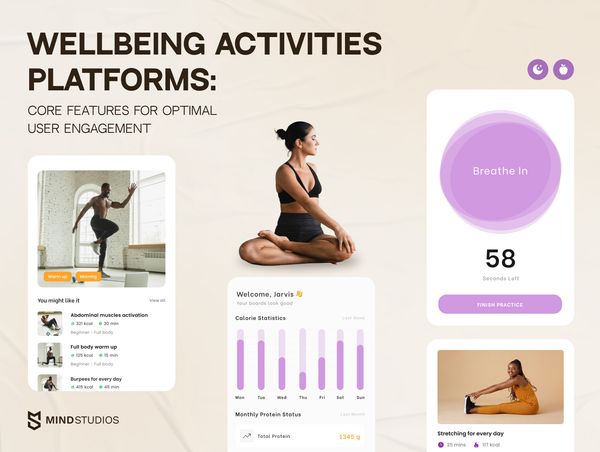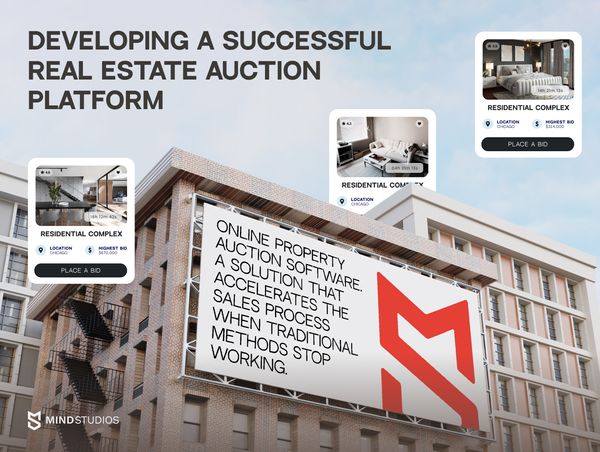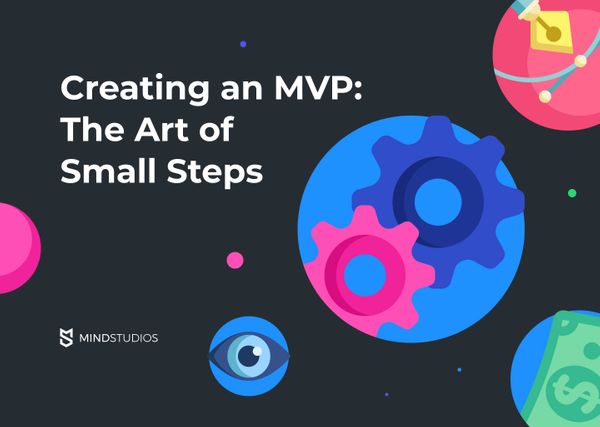
Building MVP is no simple task. Startup founders face great disappointment when, after months of exhausting work and large sums of money spent, their company fails to withstand the fierce market competition.
Here’s what the US Bureau of Labor Statistics tells us about the survival rate of private sector establishments:
- 20% of new businesses fail in the first year.
- 34% of businesses close within the first two years.
- More than 50% of businesses remaining after the second year close by the fifth year.
- Only 30% of businesses cross the 10 year threshold.
Startup founders face great disappointment when, after months of exhausting work and large sums of money spent, their company fails to withstand the fierce market competition.
However, there’s a simple way to assess the viability of a business idea.
Financial and technical concerns along with the risk of failure led entrepreneurs to develop the concept of a minimum viable product (MVP). An MVP is a simplified version of a fully functional product. An MVP is the cheapest and quickest way to receive initial feedback from users so you can improve your product.
Though Mind Studios is more comfortable working with MLPs due to their advantages, we are experienced in developing and delivering MVPs. Contact our experts if you have a solid concept and want to see it carried out to completion.
In this article, we’ll highlight the top reasons for a minimum viable product development and the benefits of an MVP. We’ll also outline how to build an MVP and clarify what level of “minimum” it should be, discuss common mistakes while building MVP for startups to help your idea survive despite today’s cutthroat business climate, and introduce you to some inspiring examples of successful MVPs.
The need for an MVP: Its benefits and goals
MVP goals
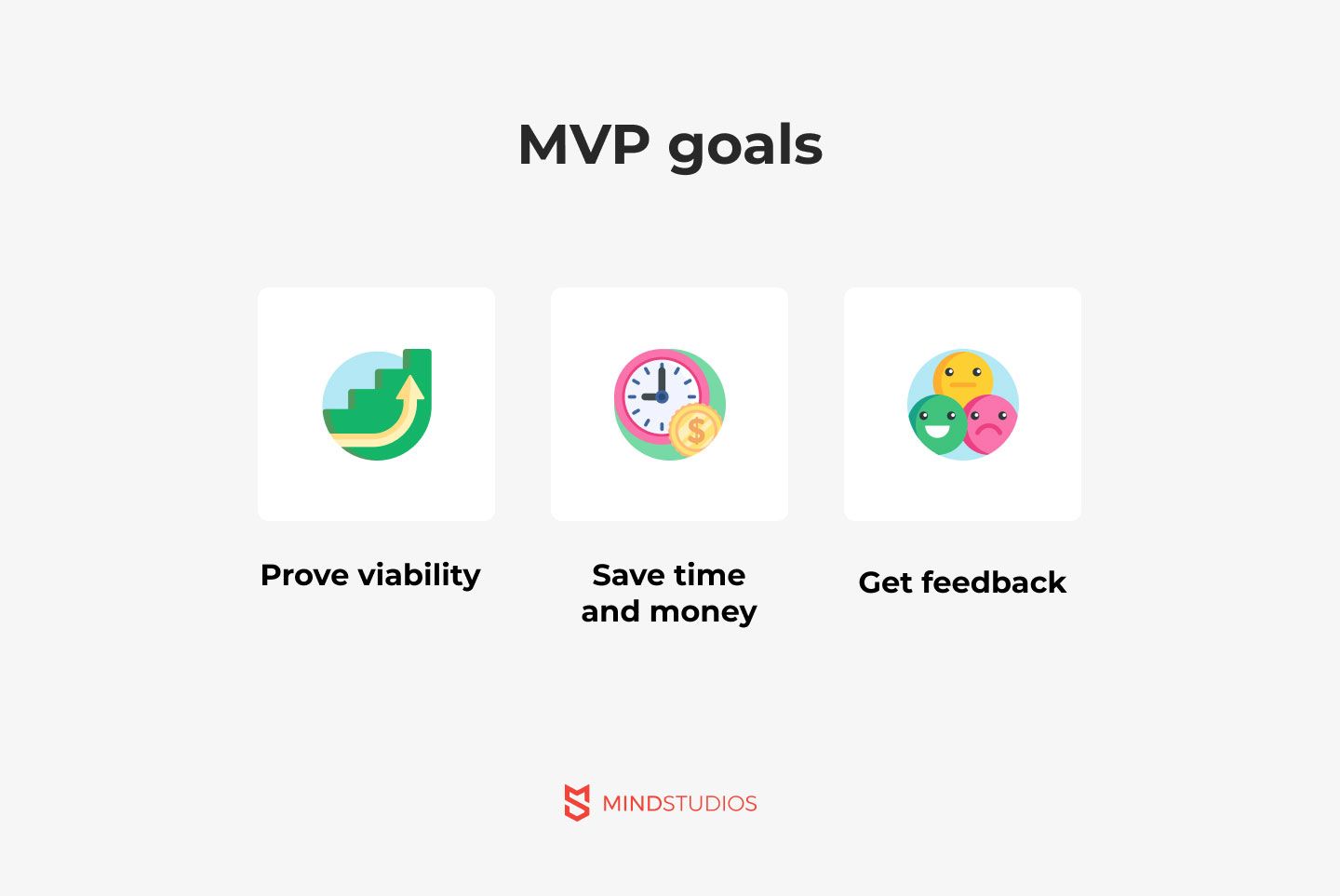
Building an MVP for your product achieves three goals:
-
Prove the viability of your idea.
“Success is not delivering a feature; success is learning how to solve the customer’s problem.” Eric Ries, The Lean Startup
To be successful, a product should first of all engage users by solving one priority problem. A minimum viable product allows you to find a balance between what you’re offering and what your users want. This allows you to prove the viability of your hypothesis before creating a full-fledged website. Launching an MVP allows you to figure out how strong users’ desires are to find, install, and use your product — and to share positive reviews about it.
-
Cut development time and costs.
While building an MVP, you focus on a short list of features, a simple design for your app, and solving a problem your target audience has. This approach enables startups to launch with less money, time, and effort and quickly find initial customers. The purpose of building an MVP is to present your idea even with a lean budget. -
Get initial customers and feedback.
An MVP complies with the main principles of the lean startup methodology: build, measure, learn. Learning from initial customers is easier with an MVP than without. You can use your MVP to check metrics:
- Number of people who have visited your website
- Cost to attract one visitor to your web app
- How many users make purchases over one day/week/month
- How often users visit your website or mobile app
- Average time between registering and making the first purchase
You can use this data to improve your MVP by iterating the web development process to eliminate bugs, and increase users’ commitment to your web product.
MVP benefits
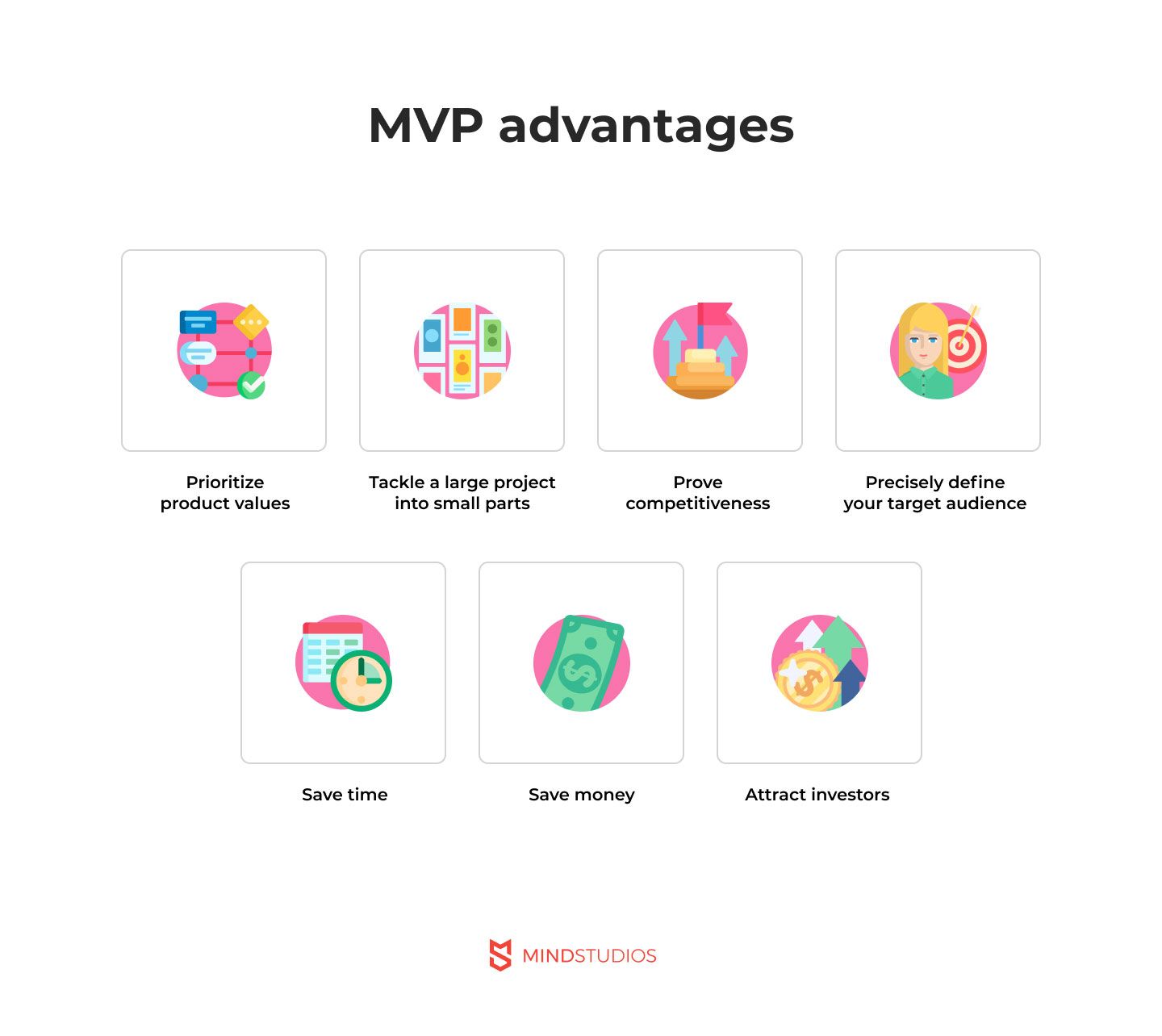
Building an MVP before your full product has undeniable benefits:
- Focus on core values. A minimum viable product contains minimum functionality. Pick out your web project's core value — one really worthwhile functionality that will no doubt solve users’ needs — and build an MVP around it
- Easily start a big project. With massive projects, when you doubt success, it’s best to focus on a small piece of functionality and make it as good as possible. It’s much easier to build an MVP and test an idea’s viability than it is to develop a feature-rich application from scratch and see it fail.
- Define your target audience. Users who engage with a simplified version of your product are exceptionally valuable, as they show interest in the product’s core value and thus can offer important feedback. It’s crucial to do everything possible to get your first customers and get genuine feedback on your idea. Besides, with an MVP, you’ll be able to figure out more about your target audience, including their pains, interests, preferences, and buying behavior.
- Prove your product’s competitiveness. An MVP allows a product owner to examine whether their product is unique on the market. In an MVP, you highlight the best features of your product and demonstrate a way to solve users’ problems. This approach can make users loyal to your brand and, as a result, reveal the benefits of your product compared to competitors’ products.
- Save time on product development. Building an MVP takes less time than making a full app. The faster you build an MVP, the faster you’ll get user feedback. An MVP allows you to define the perfect version of your product quickly.
- Save money. As an MVP requires you to build only a very few features, you don’t need to spend an enormous amount at once without proof that your website or mobile app will find success. If it does prove successful, you can use the resources you’ve saved for further development and feature implementation. But if your MVP fails, you’ll have only spent money on MVP development, not creating a whole web project.
- Attract investors. Starting business with a well-performing minimum valuable product can be crucial for attracting investors. If your MVP is well-received, it will prove the viability of your business idea. Thus, it will be much easier for you to find investment for further development.
How to build an MVP?
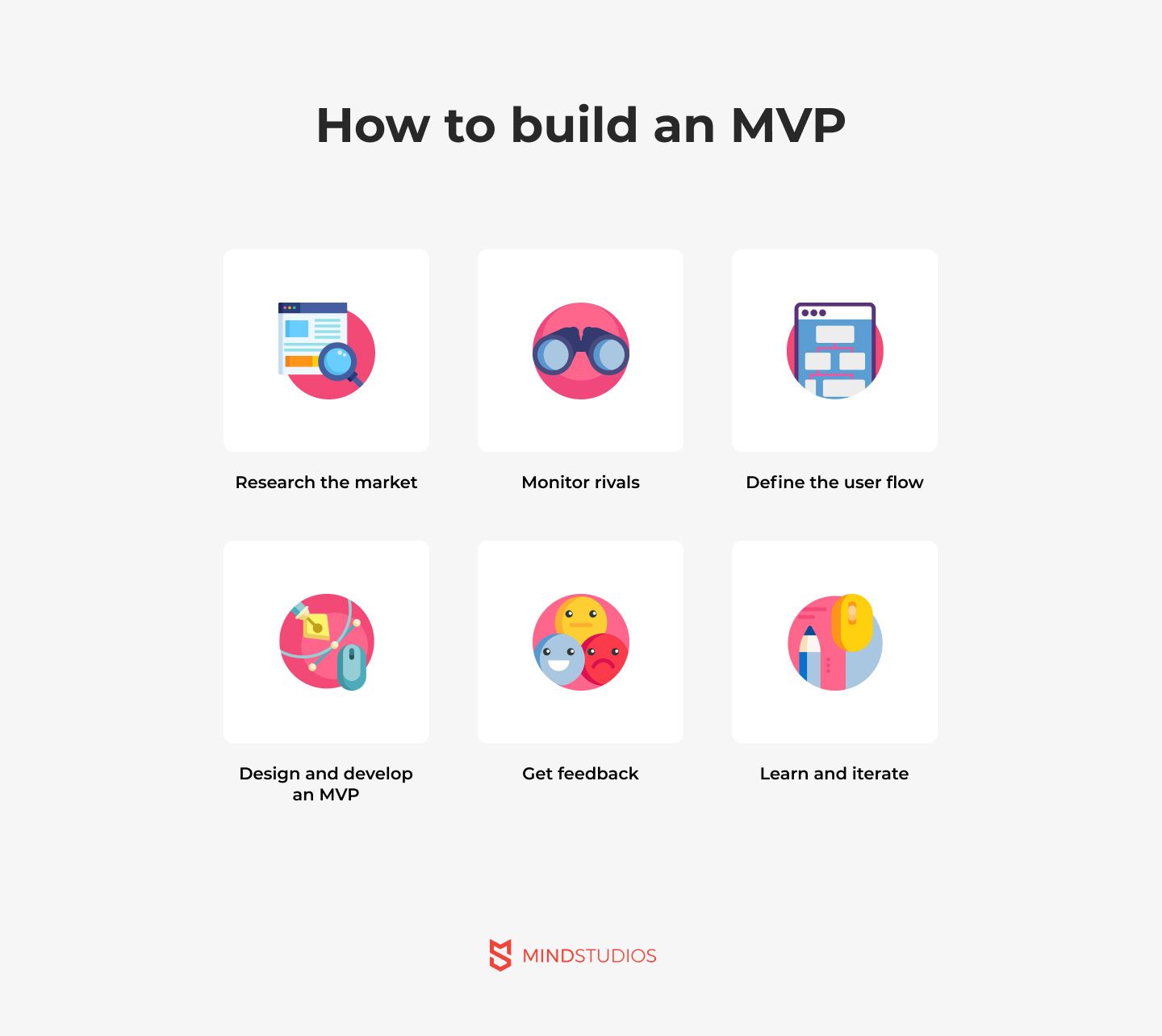
Building an MVP allows you to focus on the most crucial features of your product so you can save time. As Eric Ries says:
“The lesson of an MVP is that any additional work beyond what was required to start learning is a waste, no matter how important it might have seemed at the time”.
This quote perfectly illustrates the importance of MVP app development. Next, we’ll list the essential stages of the MVP development process.
Stage 1 — Research the market
Over 70% of startups fail within the first five years, according to a survey by Failory. The inability to secure capital, low customer demand, or incorrect market targeting are common causes of startup failure. Inadequate research, idea validation, or lack of market fit can all contribute to this. Another reason a firm might not succeed is because its founders failed to target their audience properly or establish their specialty. Thus, our first recommendation is to double-check your answers to these two questions:
- What does your target audience need?
- Does your product fulfill these needs in the way users expect it to?
To answer the first question, you’ll need to deeply investigate who your customers are, what habits they have, what challenges occur in their lives, and how you can help to overcome them. There are many web platforms like SwagBucks, OnePoll, and Toluna that will help you create a detailed portrait of your target customer.
To answer the second question, you can use a business model canvas to describe your product vision. This useful tool demonstrates the value of your web project, how it works, its target audience, and your estimated budget. You can use a business model canvas to view the entire structure of your business model and see how parameter changes into one key category will impact on other categories. A business model canvas will clearly show you what problems your target audience has and how your product will solve them. Only after confirming the usefulness of your business idea should you move to the next stage.
Stage 2 — Keep an eye on rivals
The web app market is constantly growing, with thousands of new mobile apps and websites appearing every day. A strong belief in the uniqueness of your product isn’t enough to launch an MVP immediately without competitor analysis. To convert website visitors into loyal customers, your product must be better than others in the same niche. It’s quite easy to say your product is better, but how can you measure it? Web tools like App Annie, SimilarWeb, App Radar, Quantcast, Sensor Tower, and MOZ give you valuable insights into how competitors’ web businesses work. You can use these tools to get data about:
- How many people use competitors’ products (e.g. monthly traffic)
- Which sources bring more users to competitors’ apps (traffic sources)
- Where your competitors’ apps are the most popular (geographic locations of your target audience)
- The rank of your competitors’ products (in your country or globally)
In addition, you can analyze feedback from your rivals’ customers. When starting to build your MVP, you can address shortcomings of competing apps. To build a successful MVP for startups, it would be useful to adopt the best from competitors’ solutions and avoid competitors’ mistakes.
Stage 3 — Define the user flow
Once you’ve passed the first two preparatory stages of creating an MVP, it’s time to outline the user flow or what steps your customers will take in your app when they need to accomplish a task. If we imagine your product as a city, then the user flow is the roads that lead users to the desired destination. To outline the user flow, you need to build a user flow diagram, which will help you to:
-
define potential problems with your app and what can be improved
-
see the whole picture of the user flow: what attracts customers to your app, what they do while using it, and what they do after leaving
-
compare what customers need and search for with what your app offers
-
guide users through your app and encourage them to take an action
-
figure out where you can most effectively put your lead magnet or call to action
There are several tools you can use to create a user flow diagram, including XMind, MURAL, and UXPin.
Stage 4 — Highlight your MVP features
The next stage is sketching out all features for every basic piece of functionality your customers are likely to need when using your mobile app or website. You can do this by writing down every feature while keeping in mind what users want. Further, you need to divide all these features — for example, using the MoSCoW technique: must-haves, should-haves, could-haves, and wish-to-haves or will-not-haves at the moment. After prioritizing features, you’ll arrive at a list of crucial features for your MVP.
Stage 5 — Design and develop your MVP
Once you’ve approved the main concept of your app and defined the basic functionality and user flow, you’ll need about two or three months to go through the MVP design and development stage. You can start with wireframing the main screens and navigation methods for web, iOS, and Android. To save time and money, you can try one platform for your MVP and add other platforms later. Another way to create your MVP cheaper and faster is to choose cross-platform development.
The design of your MVP screens must be simple and clear for users, not overloaded by complex, time-consuming, and expensive UI elements and animations. You can also work with a outsourcing company that has a team of skilled specialists who can help you come up with an optimal design and development methodology.
Stage 6 — Get feedback, learn, and iterate
The last stage of MVP development consists of collecting feedback from initial customers. You should meticulously analyze this feedback to understand where you should go with your product development. After getting feedback, you’ll know what your product did well and what it lacks, and you’ll know what you need to change or improve.
Your MVP might go through several iterations of the build–measure–learn cycle before you have a high-fidelity competitive MVP that can be a base for launching your project.
How to build an MVP quickly
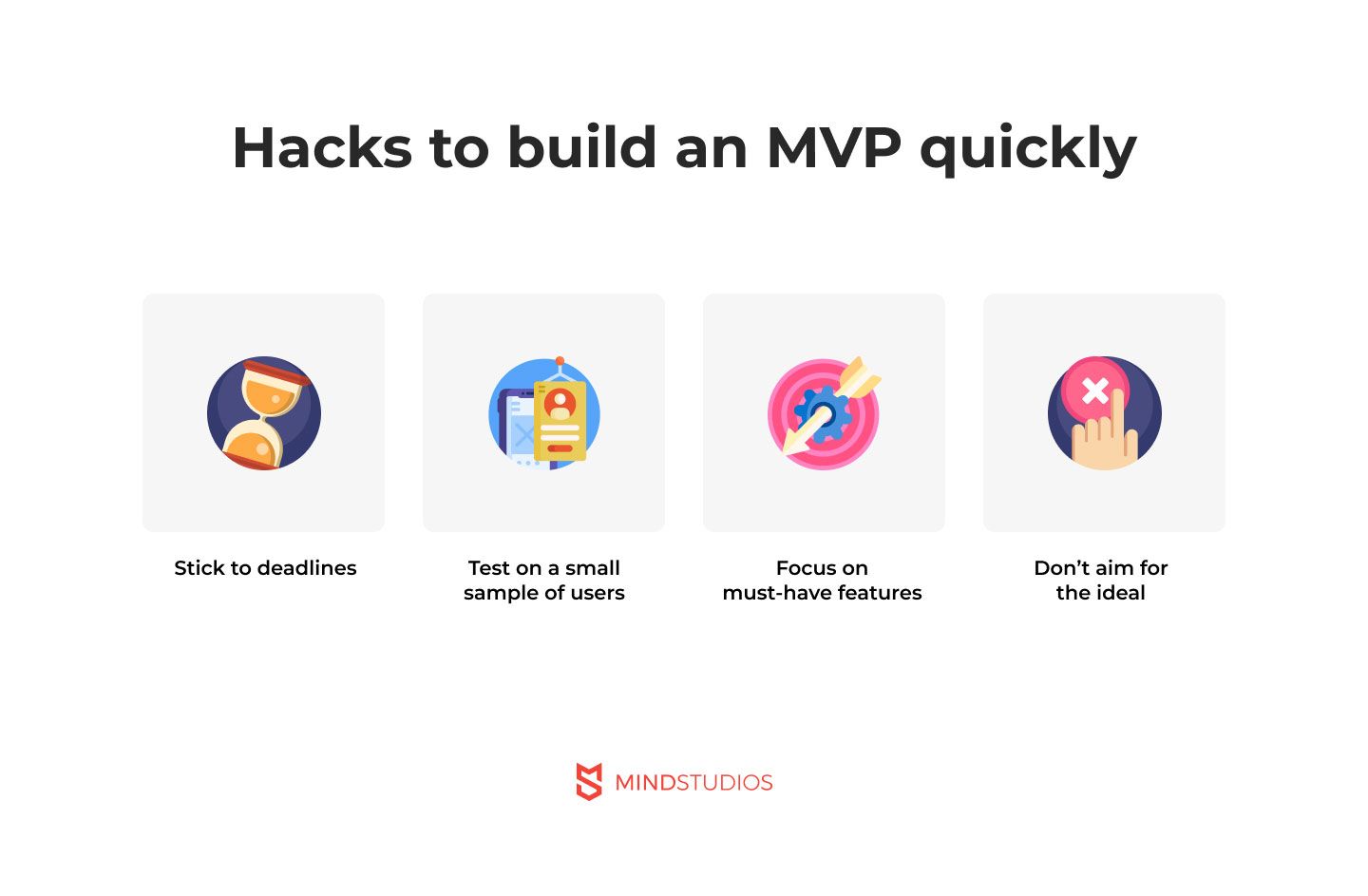
Let’s assume you’ve decided to use a lean pre-launch tool for your app and have begun to develop an MVP with core features. You’ve also started a build-measure-learn cycle to create a basic app that isn’t overloaded. But how “minimum” should your MVP be? Some first-time entrepreneurs focus only on the “M,” forgetting about the “V.” There’s a very fine line between a maxed-out and half-baked MVP. We’ve prepared tips to help you strike the right balance.
- Time box your MVP development.
In pursuit of an ideal MPV, it’s easy to get bogged down cutting, iterating, and improving the final results. But if you do this, MVP development could last for years. To avoid falling into this trap, determine the terms of MVP development. It should take you only about two or three months to launch your first minimum valuable product. Set clear deadlines. This shouldn’t be a long-term job. - Appeal to a small group of users.
Your main target at the MVP stage is to start getting initial customers: a few, tens, or a hundreds. No matter how many, just get them. Choose a limited location for testing your MVP. Appealing to a small target audience is cheaper and faster than coping with numerous users’ feedback. - Focus only on must-have functionality.
Funnel all your attention into solving a single problem for your users. Extract only a few features that will prove your idea is unique and worthwhile. Remove features until you can create your MVP within your deadlines. - Create a useful, understandable, and attractive app.
On the other hand, a basic MVP must be attractive. It should have a comfortable interface, high-quality photos, expert content, understandable calls to action, and simple contact and payment forms. As we’ve mentioned above, one of goals of an MVP is to draw users’ attention to your genius product and make them loyal to your new brand. - Don’t expect your MVP to look perfect.
Your first app prototype won’t be perfect, but it doesn’t have to be. You don’t need to fall in love with your MVP. These are MVP features: they don’t have complete functionality and they don’t suit all your requirements for a full product yet.
Prioritization of MVP features
When building an MVP, it may be challenging to find the right balance of features that are sufficient to attract and retain early users while keeping the product lean enough to allow for quick adjustments based on feedback. The goal is to include just enough functionality to solve a core problem for your target audience, demonstrating value without overcomplicating the initial offering.
To make sure your aim is true, you need to conduct a deep analysis of your potential consumers, their pain points, and the existing solutions they use. Let’s consider which tools can help you identify target users and analyze competitors before building an MVP.
Identify target users
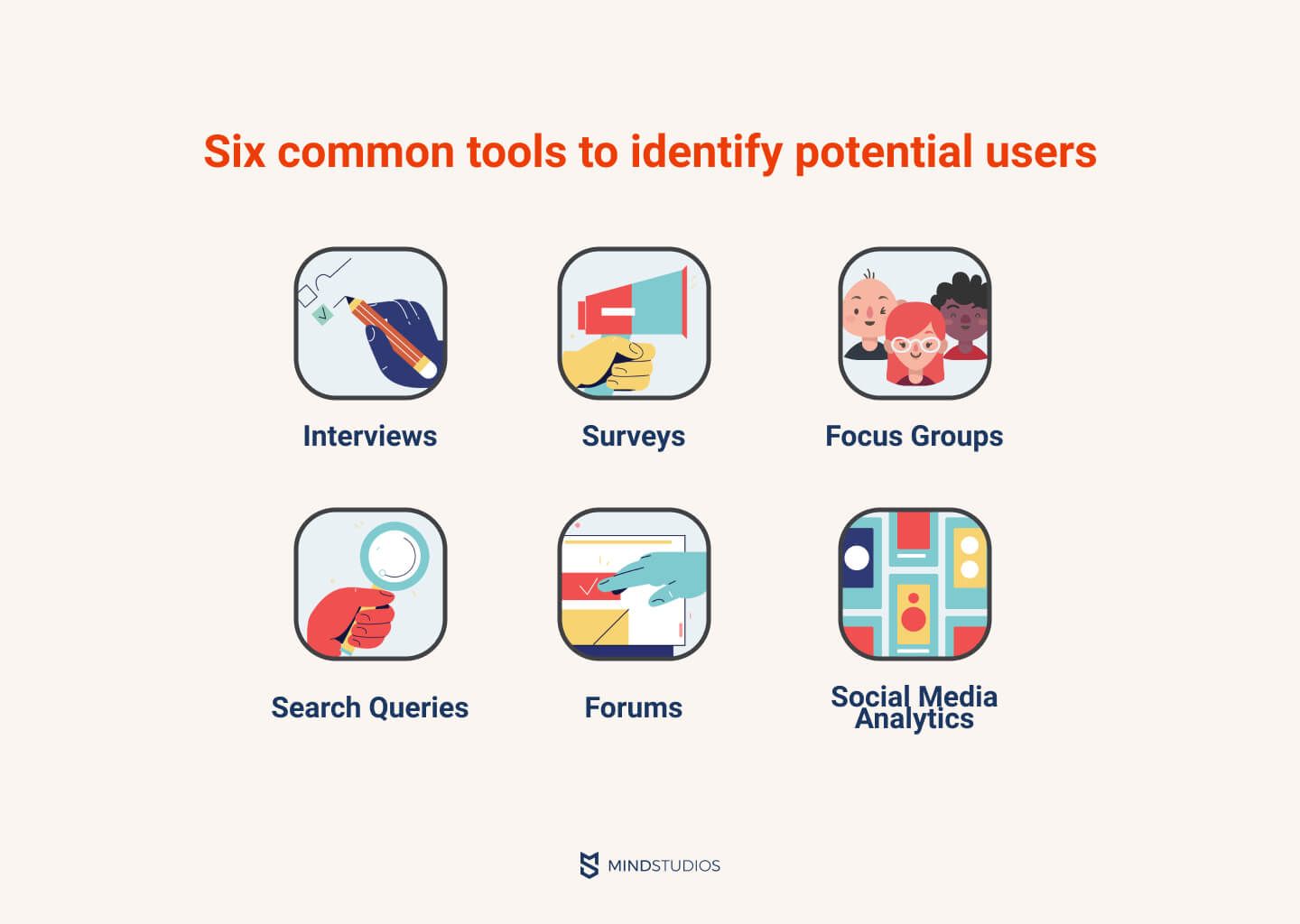
When you have an offline business or website, it means you have a current customer base. When building a mobile app, you can take your existing customers as a sample of your potential app users and get insights using Google Analytics, for example.
But what if you’re creating a mobile app from scratch and have no customers at all? In this case, you can apply a lot of tools, both offline and online, to get insights into your intended audience. These tools include both qualitative and quantitative research. Qualitative research means focusing on the feelings, emotions, and opinions of a target user, while quantitative research focuses on statistics, hard facts, and analytics.
Common tools for features prioritization include:
- Interviews;
- Surveys;
- Focus groups;
- Search queries;
- Forums;
- Social media analytics.
All these methods are aimed at gathering extensive information about your potential users and segmenting them according to the following characteristics:
| Criteria | Characteristic |
|---|---|
Demographics |
Age, gender, ethnicity, location, income, education level, job type, family status |
In-market behavior |
Sorts of goods/services people buy, frequency of purchases, solvency, reasons for buying the product or service |
Psychographics |
Personality types, values, interests, needs, pain points, motivations, attitudes, opinions |
Preferences |
Type of platform, device, social network, favorite apps, ways of making decisions, and more |
This isn’t a short list, of course. You can add or remove characteristics and change or increase the list of criteria according to your business specifics.
Based on research into your target users, you can move to the next step on the way to defining MVP features for your mobile app — creating a fictional portrait of your ideal user called a user persona.
Draw up user personas
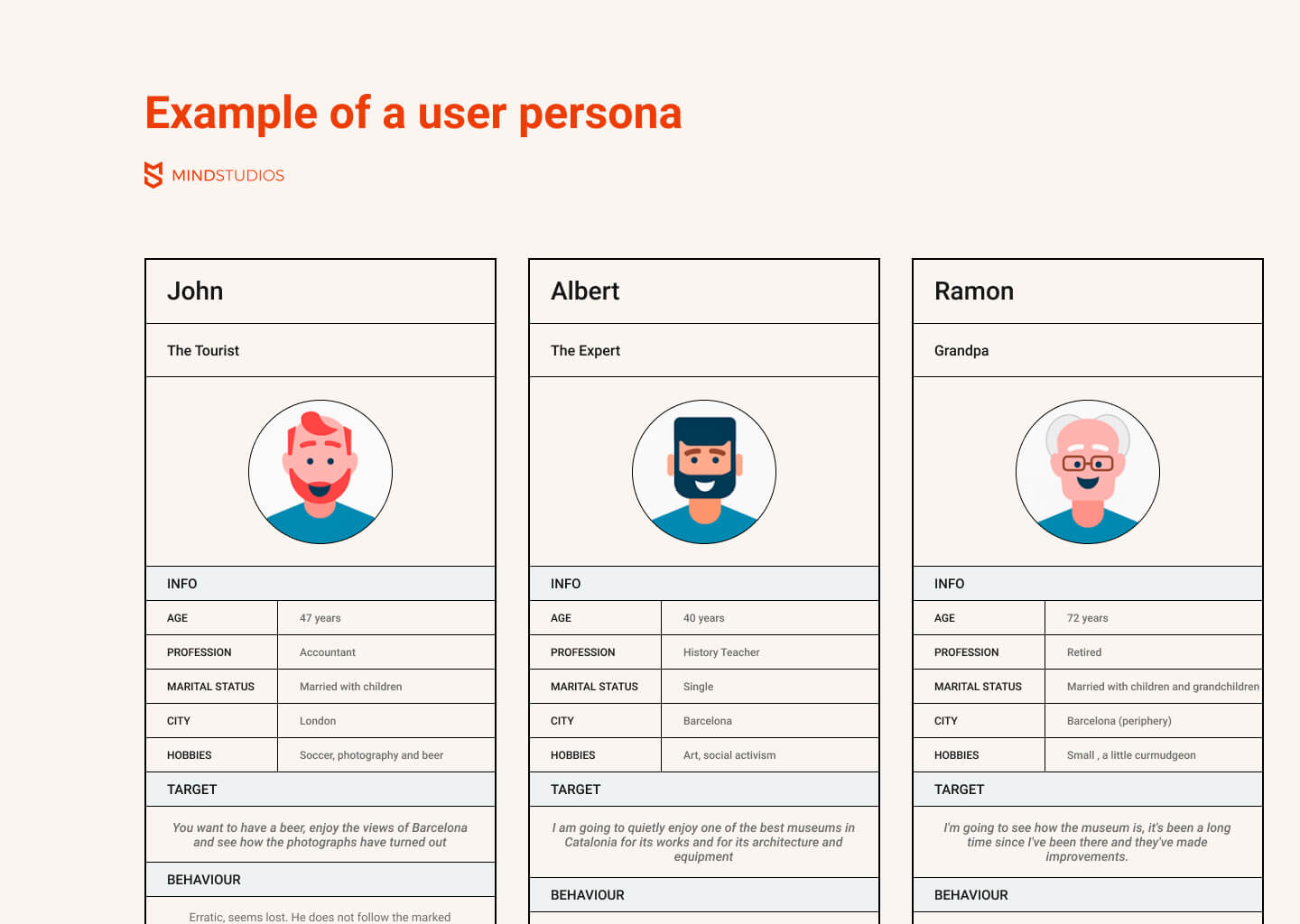
User personas visualize your most common and valuable types of users. You can see some examples of user persona designs on Dribbble.
In brief, a user persona includes four key blocks:
-
Header
-
Demographic profile
-
End goals
-
Scenario
Give your user persona a name, pick a photo, and add a summary of the key reasons the persona is interested in your app. This is what the header should include. In the demographic profile, you should write down the persona’s personal and professional background, preferences, experiences, and psychographic data that you’ve received from primary research. The end goals block needs to tell what the persona wants or needs to accomplish using your app. You can focus on users’ goals, wants, needs, and fears. In the last section — the scenario — you need to describe a story of how the user persona would interact with your app in a particular situation to fulfill their goals.
Let’s summarize some tips to make your user persona great:
-
Be easygoing about the design and focus on the content.
-
Don’t add irrelevant or made-up information. Add only information that has a bearing on the development of your project.
-
Don’t revolve around demography; give priority to users’ needs, pain points, wants, and goals.
-
Tell a story to make your user persona tangible and real.
-
List solutions your persona falls back on and mention the frequency of use.
-
Mark the most important insights to make your user persona understandable for your app development team.
Analyze your direct and indirect competitors
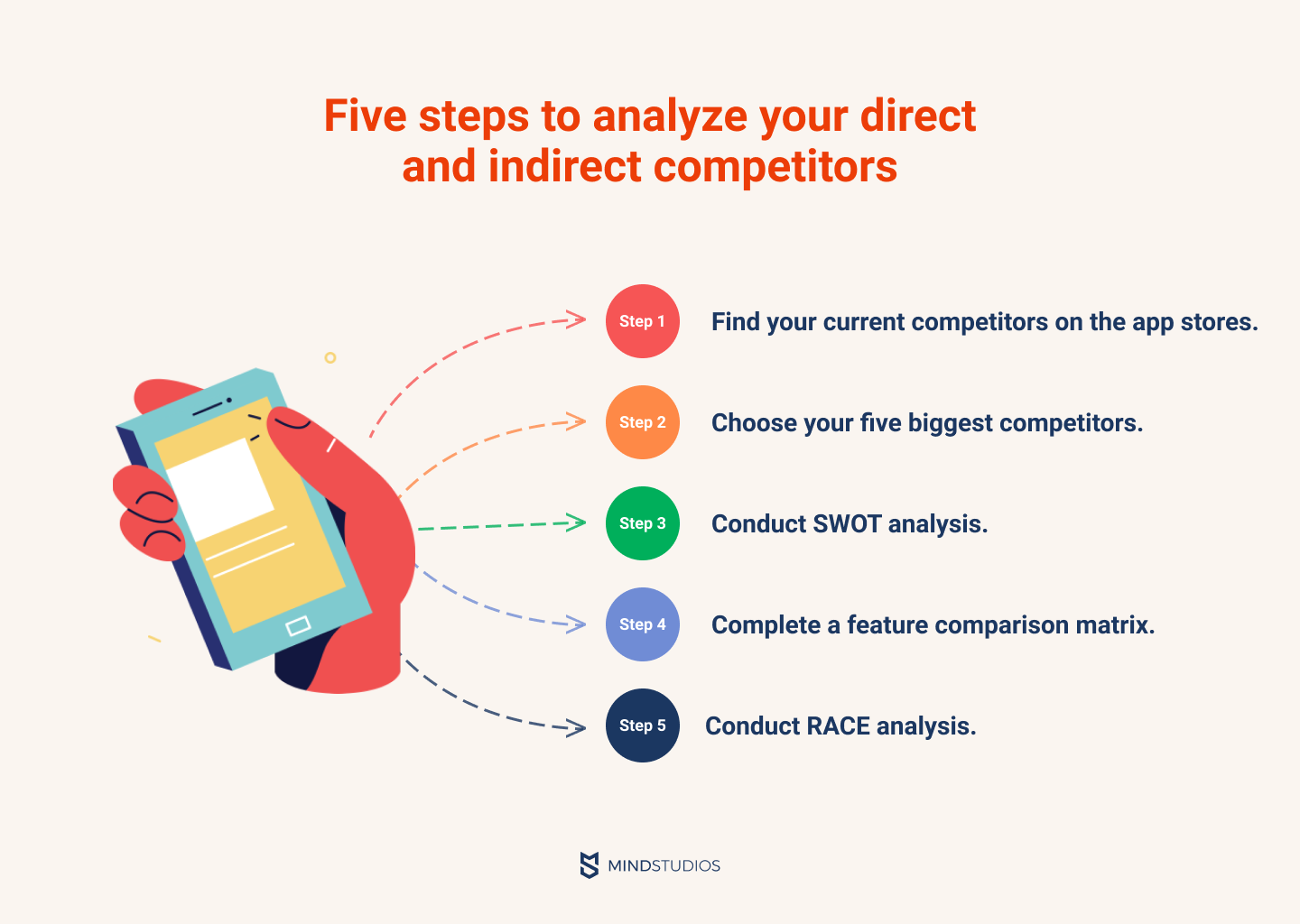
After identifying your target users, it’s time to inspect the mobile apps they use to meet their needs. These apps could represent both your direct and indirect competitors. Direct competitors offer a solution similar to yours to your target audience. For example, if you want to create an ebook app, Kindle will be your direct competitor. Companies that offer different products and/or services to your target users will be your indirect competitors. If you come up with an idea to create a healthy food delivery app, Nike Training Club will be your indirect competitor.
To get a better grasp of what MVP features for app your intended users value, you need to analyze both your direct and indirect competitors by taking the following five steps:
-
Step 1. Find your current competitors. Conduct general search on the Google Play Store and Apple App Store using keywords relevant to your app.
-
Step 2. Review category rankings. App store rankings inform you about the big players and the newcomers. Focus on your biggest competitors. Narrow down to five competitors to analyze.
-
Step 3. Conduct SWOT analysis. Discover the strengths, weaknesses, opportunities, and threats of your competitors. To do this, check their app descriptions, app screenshots, and user reviews.
-
Step 4. Complete a feature comparison matrix. Make a list of mvp features for apps and competitors, then match which features those competitors offer. As an example, see the feature comparison matrix on EdrawSoft.
-
Step 5. Carry out RACE analysis. Figure out how your competitors:
- Reach users (efficient acquisition channels, traditional and/or digital marketing strategies)
- Encourage users to Act (effective ways of motivating users to make in-app purchases, share social media content, leave a review, invite a friend, etc.)
- Convert leads (tools to persuade users to buy like free trials, free shipping, discounts, abandoned cart campaigns, and more)
- Engage users to become brand advocates (retention strategies to gain loyal users including push notifications, loyalty programs, and gamification)
Form Your Unique Value Proposition with MVP Prioritization Matrix
“See where your competitors are focusing — and then make different choices.”
Larry Keely
After detailed market research, it’s time to shift your focus to the solution you’re going to deliver to your users and sidestep your rivals with. You should explain three things to your users:
-
Applicability. What product or service will your app provide? How will your app serve users’ needs?
-
Quantitative value. What specific benefits will your app possess? What is the end benefit of using your mobile app?
-
Differentiation. What makes your app unique? Why should users use your app and not a competitor’s?
Answering these questions will help you form your unique value proposition (UVP). It will be a cornerstone of your minimum viable product and your guideway through MVP feature prioritization.
List all your wants and needs
Prioritizing features in a mobile app MVP is impossible without creating an exhaustive list of features you plan to provide. You should include features that:
-
users need and want according to your target audience analysis
-
receive positive reviews and adopt the strengths of your competitors
-
make your app stand out from competitors and make users leap to your app
-
form the core of your viable product (your app couldn’t exist without these basic features)
-
could be “boosters” for your UVP and increase user engagement
-
include trends, innovations, and high-tech solutions in your niche
This list will give you a rough idea of all the MVP features your app is supposed to deliver. Now you’re ready to define what features should be woven into your minimal viable product.
What to do after creating an MVP: Key performance indicators
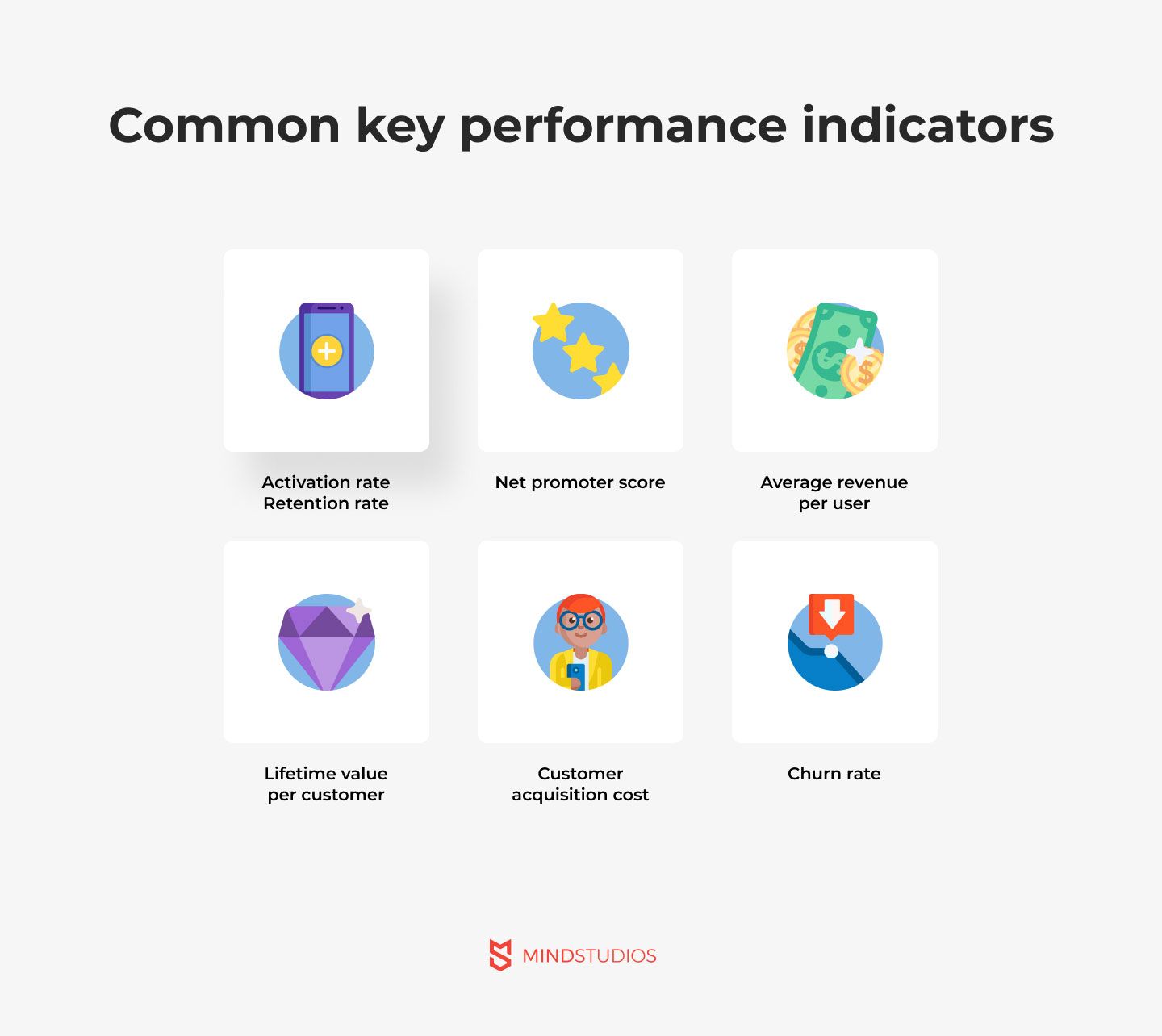
After you deliver an MVP, the question arises: "What's next?" Taking a cue from the snowball effect, MVP development begins with a small goal and then, as the project progresses, incorporates user feedback to inspire much more detailed roadmaps. It is crucial to prioritize and backlog further features for development after the MVP, in line with the appealing properties of the Kano model theory, to prevent extending the development stage.
Once you launch your MVP, there won’t be time to rest. You need to track by what channel your MVP enters the software market (AppStore, Google Play, etc.), what impact it has on target users, and how it fits your business requirements for future web project development. There are different types of key performance indicators, and which you should choose depends on what kind of project you’re building. The following are common key performance indicators that can help you define the success of your app at launch.
- Activation rate. This KPI shows how good of an impression your minimum viable product leaves after the first use. If your app makes users open it, register, read content, and fill in a contact form — in short, do any activities that could lead to repeat visits — it means you’ve dealt with a real problem and have prepared a real solution.
- The retention rate is the percentage of repeat visitors. Let’s say your goal is for XX% of users to open your app three or more times in the first 30 days. Your retention rate demonstrates the uniqueness of your idea. In other words, it shows if your MVP has something useful that no competitors offer such that users will come back to your app again and again.
After finishing the MVP, gathering user feedback and integrating their suggestions into subsequent tasks becomes essential. This process is known as beta-testing. Outbound marketing tactics are also a part of the MVP launch, testing, and repairing. Here are some additional metrics that will help you validate your MVP:
-
The net promoter score (NPS) is a feasible way to measure an MVP’s success and highlight users’ impressions of your product. You can ask users to rate your MVP from 0 to 10 after using it. After receiving feedback, you can divide users into two groups: promoters with ratings of 9 and 10 and detractors with ratings from 0 to 6. Using these numbers, you can calculate your NPS:
NPS = Percentage of promoters - Percentage of detractors
-
Monthly average revenue per user (ARPU) shows how much revenue you receive on average from one customer during one month.
ARPU = Total revenue per month / Total number of users per month
ARPU will help you calculate the approximate monthly revenue one customer brings you so you can estimate your financial flows.
-
Lifetime value (LTV) reflects the amount of money a customer will spend on your product while using your app. This metric can be measured with the following formula:
LTV = ARPU (average monthly recurring revenue per user) * Customer lifetime
-
The customer acquisition cost (CAC) shows how much it costs to get a paying customer. You can calculate it using the following formula:
CAC = Money paid for getting traffic / Number of customers gained from this traffic
By measuring your CAC, you can estimate the budget needed to get enough customers when developing a full web product.
-
Churn rate. Naturally, there will be users who stop using your app or just uninstall it. That’s okay, but you need to keep your finger on the pulse and know the churn rate:
Churn rate = Number of uninstallations per week or month / Number of users at the beginning of the week or month
Check your churn rate to make sure your MVP doesn’t have obvious bugs and consistently gains new users.
Furthermore, data analysis is crucial for post-MVP development, emphasizing user engagement, session duration, and retention rate KPIs. Equally important is user feedback, whether it be in an app store or any other platform.
To make lucrative improvements, the DIBB method lays out a cycle of data-driven predictions: data, insight, bet, and belief. The significance of empathy in responding to customer complaints is highlighted when negative evaluations are seen as chances to enhance.
If you want to take your MVP to the next level and become an MLP (Minimum Lovable Product), you need to listen to your users throughout the app’s life cycle, analyze their data, and upgrade your technology accordingly. Making items more marketable isn't the end goal; what matters more is demonstrating to consumers that their opinions matter during development.
Development mistakes to avoid while building an MVP
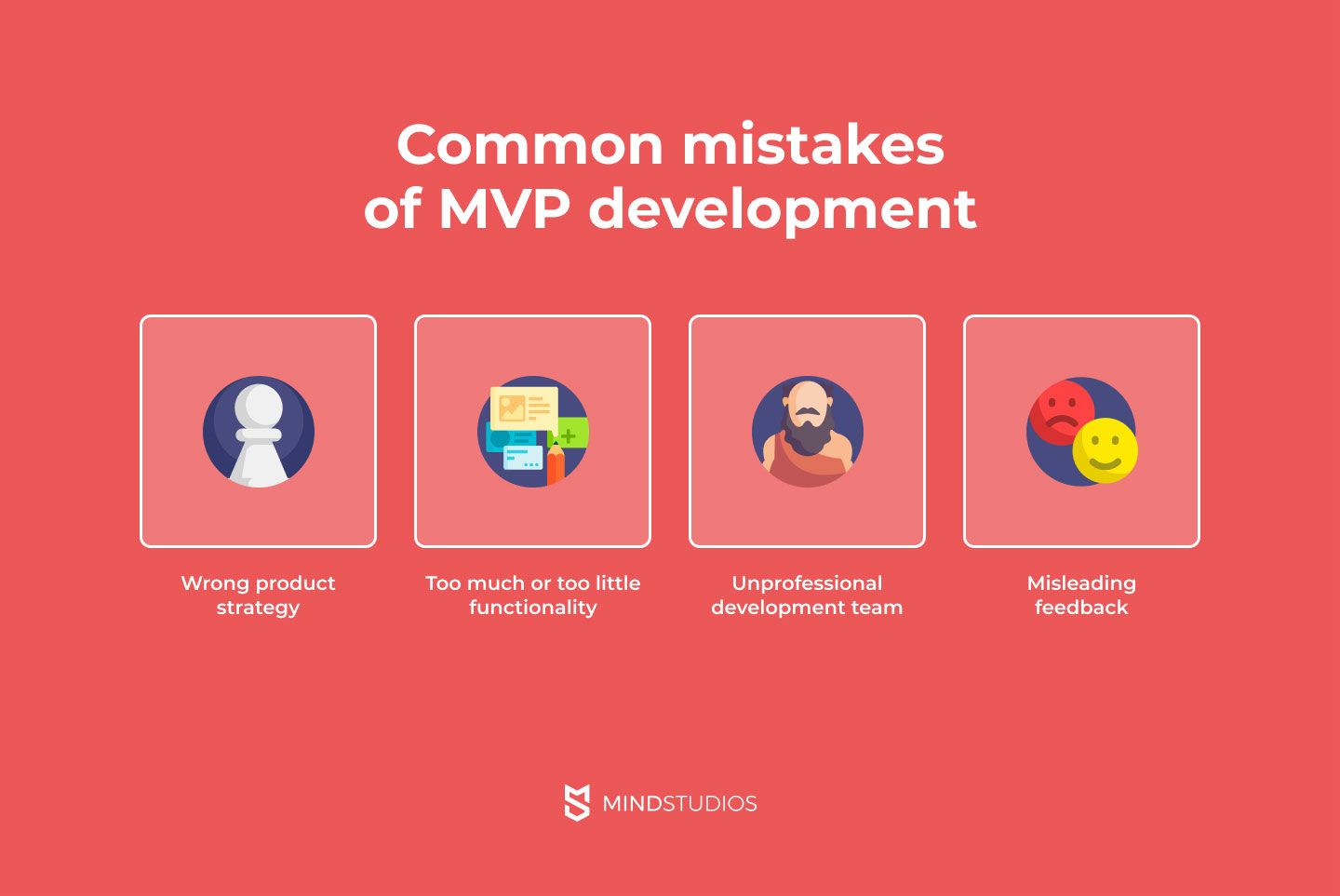
As you can see, building a balanced MVP is an art. In this part of our article, we’ve prepared a list of the most common mistakes made by entrepreneurs when transforming their brilliant business ideas into sustainable and successful apps. For each of these four MVP mistakes, we also suggest ways to overcome them.
Mistake 1 — Wrong product strategy
Your product strategy is the engine of your business. You can use it to transform your financial and timing investments into palpable results — and you can’t go far if your engine isn’t running.
Here are the indicators of a wrong product strategy:
- The problem you’re solving is actually irrelevant. Once an MVP is almost complete, the owner may be shocked to realize there’s no need for the product. Eric Ries was right when he said:
“What if we found ourselves building something that nobody wanted? In that case what did it matter if we did it on time and on budget?”
- Your marketing and sales plans are uncertain. What is your target audience? How much will it cost to attract the first 100 users? Where will users come from? If you have no answers, you have a poor product strategy.
- You can’t define your core differentiator. What’s the level of competition? Are you going into a niche that hasn’t been mastered yet? Or are you diving into a pool full of business sharks? Whichever it is, you must know what can make your web product reach the top.
What can help:
- Communicate with your target audience. Communicating with users who face problems daily can awaken a fantastic idea for your product that will provide for your users a reliable solution.
- Plan your sales activities and marketing campaign. If you don’t have a professional in-house marketer, you can hire a remote specialist or outsource your marketing to a third-party company.
- Clearly define your vision. No matter what kind of web app you’re creating, you won’t succeed without a deep understanding of the product’s main purpose, core values, and trump cards. You can use the Radical Product Framework together with the Lean Startup and Agile approaches to succeed in developing an MVP.
Mistake 2 — The two extremes of MVP development: Overloaded or scarce
Sometimes, implementing a web product seems like climbing up a mountain. Just as there are many climbers with useful equipment and many trails that lead to the top, you can use manifold approaches to achieve your business goals. But there’s one principle of climbing: if you take too much with you at the foot of the mountain, it will be harder to reach the peak. And if you take too little, it doubles your chances of turning back less than halfway up.
How can you know that your MVP isn’t overloaded or too minimal?
- It takes you more than three months to create your MVP. An MVP is all about fast development. If you include too many features, it can take years.
- You hesitate while choosing what features should be included in your MVP. Many holders of genius ideas want to see a full-functioning app at the MVP stage. However, adding more and more features is a waste of time and funds because additional features are most likely not so important for target users but will delay the MVP release.
- You postpone bug fixes after building your MVP. This often happens when the app owner hurries too much to develop at least the most minimal MVP with a poor design and primal features to launch and test it.
What can help:
- Follow an Agile methodology. Divide complex requirements into several simple features. Then set time frames for delivering every feature and stick to your deadlines.
- Start with the MVP prototype. Building an MVP straightaway and skipping prototype development is like building a house without a blueprint. A prototype helps you define vital features of a high-fidelity MVP and visualize them so you can build the user experience.
- Goldilocks quality. This approach was introduced by Daniel Burka, a Google Ventures design partner. It looks like this:
“The ideal prototype should be of Goldilocks quality. If the quality is too low, people won’t believe the prototype is a real product. If the quality is too high, you’ll be working all night and you won’t finish. You need Goldilocks quality. Not too high, not too low, but just right.”
Of course, this approach isn’t completely precise, but you can use it to set your MVP load limit.
Mistake 3 — Unprofessional development team
If your product strategy is the engine of your startup, then your development team is its fuel. Whatever technologies you use and whatever is outlined on paper, if you don’t have highly experienced specialists, a successful launch is unlikely.
Let’s see how the level of your web developers’ experience influences the implementation of your business project:
- You’re behind the deadlines. Often. A low level of skills leads members of your web development team to work slowly, make mistakes, and ignore the backlog.
- You need to hire additional specialists. When your development team is unable to deal with workload, you need to hire more skilled web developers, UI/UX designers, QA testers, or project managers. But in doing so, you’re likely to go over your budget.
- You fail to improve your MVP after receiving initial feedback. When you get your first feedback from initial users, they can point out some bugs of your MVP. Inexperienced development team is unlikely to deal with these bugs, so it will be impossible to improve your MVP.
What you can do to avoid this:
- Delegate. If you face constant delays for urgent tasks, designate a responsible person who will directly ensure developers are on schedule.
- Conduct product discovery workshops. Every two to three sprints, you can hold a product discovery workshop to refine your requirements. This way, you can measure the workload for your team members and define what recruitment solutions you'll have to make.
- Find a skilled partner. You can look for skilled specialists for your in-house team, outstaff individual freelancers, or outsource your development to a web development company that has experience implementing apps in your niche.
Mistake 4 — Feedback errors
The goal of building an MVP is to receive feedback. You’ll get your first feedback from early adopters when you develop a prototype version of your MVP. Next, after you release your MVP, you’ll collect feedback from initial users. You can use all of this feedback to understand your users better and, as a result, make your MVP shine. However, despite the necessity of feedback, sometimes it can give you the wrong direction for development.
Feedback may be misleading when:
- It comes from non-target users. If your family and friends don’t belong to your target audience, they aren’t potential users of your web product and can’t give you proper feedback. Consider whether users have experience to be able to give you meaningful feedback about your product.
- There’s too much of it. The general opinion is that a lot of feedback is a blessing. But getting too much feedback can make you rapidly pivot while building your MVP. However, making massive changes to the basic version of your website can provoke constant delays and even wreck your chance to realize your idea.
- You don’t integrate quantitative and qualitative feedback. Quantitative feedback gives you answers about how many and how much, while qualitative feedback answers the why questions. If you leave out either of these views, the picture of how users feel about your web application will be incomplete.
Possible solutions:
- Accept that not everyone is a potential user. Try to differentiate users who suit your ideal profile. They can give you expert opinions and meaningful ratings. Build your MVP based only on their feedback.
- Divide feedback according to the key categories. Take a glance at the most important feedback you want to learn from. You can divide clients’ feedback according to its value, source, or type of bug, for example.
- Look at the whole picture. Consider both quantitative and qualitative feedback while analyzing what’s missing and what’s superfluous.
Real examples of MVPs
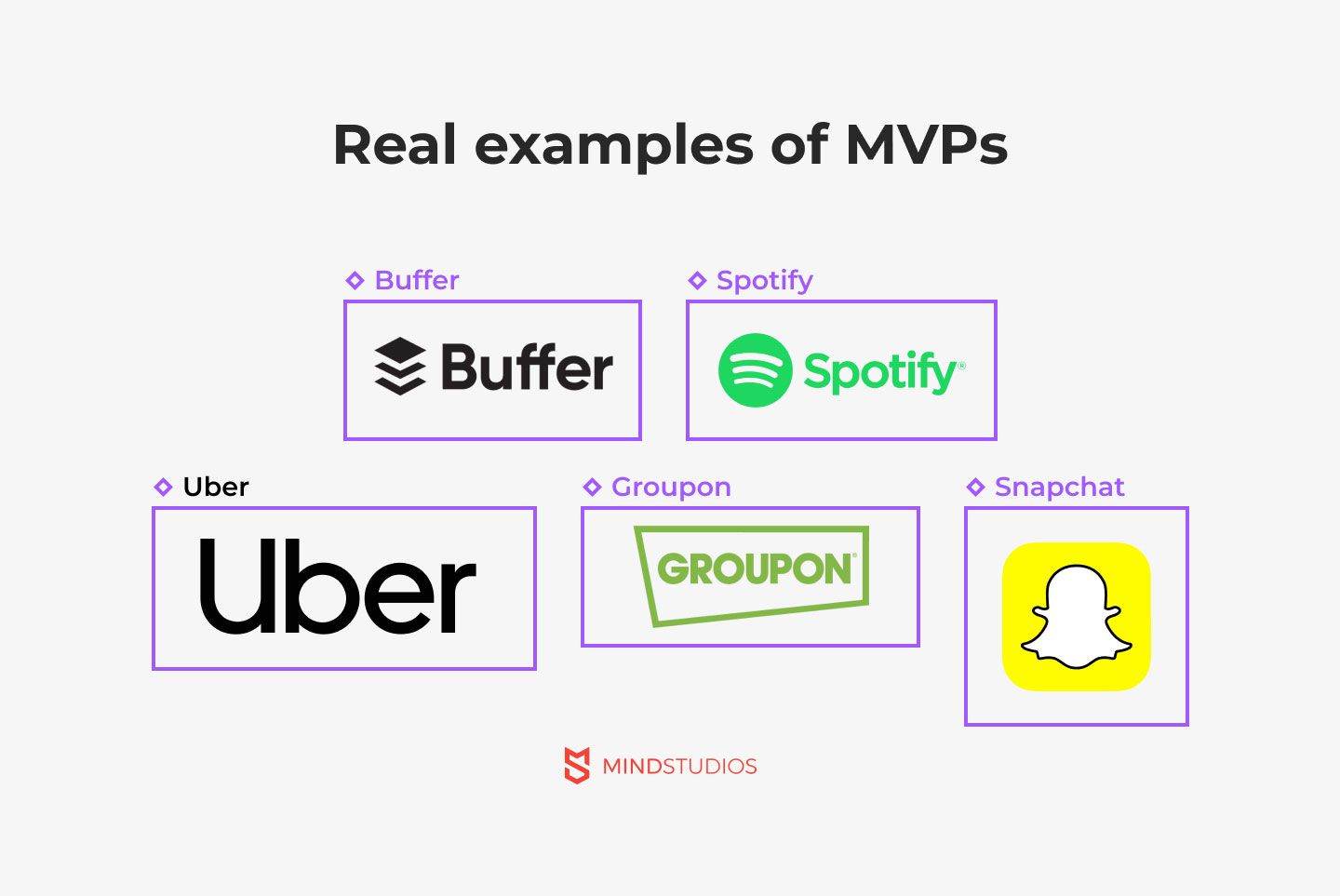
Our next job is to stop scaring you about the difficulties of creating an MVP and inspire you to believe in the success of your business idea. The founders of many popular worldwide web services have had to take the first steps to build an MVP without any guarantee of success.
We want to introduce you to several ways of implementing an MVP. To confirm their viability, we’ll show you real examples of successfully launched MVPs.
- Buffer: landing page MVP.
In 2010, Joel Gascoigne came up with a great idea came to Joel Gascoigne to make a scheduling feature for Twitter users and apps. As an entrepreneur, Joel knew how necessary it was to be on time and remember all important events in your life. He decided to check how many people shared his idea by creating a simple landing page. The information about his new product resulted in many people registering to get more information. It took Gascoigne seven weeks to build and design the initial version of the Buffer app that allowed access only to Twitter. The first user came in four days, the first hundred users came after a few weeks, and Buffer reached one million users after three years. - Spotify: one-feature MVP.
The music streaming app Spotify was born when many media piracy sites shut down and music listeners suffered from a lack of online music sources. For the first MVP version, Spotify was a closed, invite-only app that streamed legal music for free in six countries. After a while, Spotify added a community both for musicians and music listeners and actively cooperated with media outlets. In July 2011, Spotify launched in the US and became a showcase partner for Facebook, which increased their user acquisition. At that time, Spotify began to use the Chromium Embedded Framework (CEF) to simplify the process of revising different parts of their platform. In 2015, the music streaming tool was updated, adding music video and clips to Spotify. By Q4 2023, Spotify had about 576 million monthly active users. - Uber: a concierge MVP.
Often, a great business idea is born when something doesn’t fit someone’s expectations. So it happened with the co-founders of Uber, Garrett Camp and Travis Kalanick. They were frustrated by the high cost of San Francisco taxis. The MVP UberCab performed one basic function: it connected iPhone owners with drivers and enabled credit card payments. After successfully implementing UberCab, the founders added a food delivery service called Uber Eats and a courier service called Uber Rush. This innovative approach allowed Uber to expand into 90 countries as of early 2023, generating $3.1 billion in revenue by the end of the year. - Groupon: a piecemeal MVP.
A piecemeal minimum viable product uses other platforms, web services, and apps and joins them together in one platform. Groupon is an app that provides users with coupons and discount vouchers. At the very beginning, the Groupon MVP looked like a single-page website with discounts. If users wanted to print coupons, they subscribed and received a list of coupons in a PDF file to their email. This was a simple path to the biggest initial public offering after Google in 2011. - Snapchat: an MVP with disappearing content.
Snapchat was founded in 2011 by several students at Stanford University. The idea was to develop a social media platform that allowed users to post content for just a few moments before it disappeared. The new product was a hit with younger users. The Snapchat MVP (called Picaboo) only allowed users to post photos. After a successful year, the Snapchat co-founders added 10-second videos. In 2013, two more options appeared on the social media platform called Stories and Chat. Then Snapchat added other useful features like geofilters, Snapcash, and Our story. Today, Snapchat’s audience amounts to 750 million monthly active users who generate over three billion “snaps” (videos and photos) per day.
Cost of developing an MVP: Mind Studios experience
How much does it cost to build an MVP? It’s difficult to calculate the precise MVP development cost, as it depends on many factors: the complexity of product development, the number of specialists involved, the number of working hours, hourly rates, and the need to add more features.
Based on our experience, we’ve prepared information on how much standard MVP projects cost in different business niches:
- One of the latest MVPs we developed is for a video calling mobile app. Implementing both an iOS and Android MVP for a video calling app costs between $55,000 and $75,000.
- Another MVP we’ve built is for an online ebook store. The cost to develop an MVP of this type can start about $62,000.
- A food delivery app development costs between $46,000 and $54,000 for an iOS and between $45,000 and $53,000 for Android.
- To develop a job board website, you’ll first want to start with an MVP that will cost about $48,000.
- The cost of building a minimum viable product for a real estate website is about $45,000.
- The price of building an MVP for a trendy up-to-date medical website will be close to $48,000.
The owner of Virgin Airlines, Richard Branson, once said:
“Listen. Take the best. Leave the rest.”
One of the largest airlines in the world, Virgin Airlines, started with one plane flying one route between Newark and Gatwick. How’s that for a minimum viable product? If you have a brilliant idea to make our lives better, hopefully building a minimum viable product will help you find your unique way to succeed.
Final thoughts
In the challenging landscape of startup ventures, where success is far from guaranteed, creating an MVP emerges as a pivotal strategy. As a beacon of focus and efficiency, an MVP serves as a compass for entrepreneurs navigating the turbulent seas of market competition. By distilling the essence of a product into its fundamental features, startups can efficiently prove their concept, garner initial user feedback, and showcase competitiveness. The journey from idea inception to a competitive MVP involves meticulous market research, strategic competitor analysis, and thoughtful user flow definition.
At Mind Studios, we strongly believe that however complex and large a project is, it can be accomplished with a couple of well-done MVP iterations. In addition to developing minimum viable products for startups, implementing websites, and creating mobile apps for iOS and Android, we also provide consulting services. If you need to bring your idea to the software market, consult with developers, or calculate the development cost, just contact us, and we’ll get back to you.

